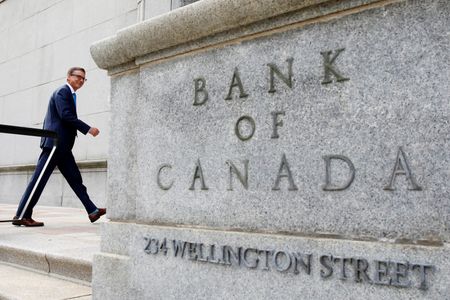By Steve Scherer and David Ljunggren
OTTAWA (Reuters) -The Bank of Canada (BoC) on Wednesday held its key overnight rate at 5% and left the door open to another hike, saying it was still concerned about inflation while acknowledging an economic slowdown and a general easing of prices.
The central bank raised rates by a quarter point in both June and July to a 22-year high and has left them on hold in the three policy-setting meetings since. Inflation slowed to 3.1% in October, down from a peak of more than 8% last year, but it has remained above the bank’s 2% target for 31 months.
“Governing Council is still concerned about risks to the outlook for inflation and remains prepared to raise the policy rate further if needed,” the BoC said in an unusually curt, five-paragraph statement.
It said it wanted to see a “further and sustained easing in core inflation.”
The Canadian dollar was trading 0.3% higher at 1.3553 to the greenback, or 73.78 U.S. cents.
But the statement dropped language used in its previous policy statement, which said “progress towards price stability is slow and inflationary risks have increased.”
The BoC instead noted on Wednesday that labor market pressures had eased and growth stalled during the middle part of the year, leaving the economy no longer in excess demand.
“Higher interest rates are clearly restraining spending,” the BoC said. Oil prices are about $10 lower per barrel than it had forecast in October.
“The slowdown in the economy is reducing inflationary pressures in a broadening range of goods and services prices,” the BoC said, noting that October core inflation was at the low end of a range seen in recent months.
“It is a stay-tuned message,” said Derek Holt, vice president of capital markets economics at Scotiabank. “They are pushing back against the market pricing for rate cuts to begin as early as in the first quarter of next year.”
Money markets are betting that there could be a rate cut as early as March, and are pricing in a cut of 25 basis points by April. Governor Tiff Macklem though has said the BoC is not even thinking about easing yet because inflation is still well above target.
“The contrasting signals highlight a Governing Council that is desperately trying to keep markets from pricing in an earlier and more aggressive easing cycle,” said Simon Harvey, head of FX analysis for Monex Europe and Canada.
The BoC forecast in October that inflation would hover around 3.5% until mid-2024, before inching down to its 2% target in late 2025. Macklem last month said interest rates might be at their peak, given excess demand had vanished and weak growth was expected to persist for many months.
“The main message from the Bank is that they believe the rate hikes are truly working,” said Doug Porter, chief economist at BMO Capital Markets. “It’s pretty clear that they’re done raising interest rates and really it’s just a countdown now to when they begin trimming rates.”
Canada’s economy unexpectedly contracted at an annualized rate of 1.1% in the third quarter, avoiding a recession, but most economists forecast that upcoming mortgage renewals at higher rates will take another chunk out of growth next year.
The BoC will start cutting rates in the second quarter of 2024 as inflation and the economy slow, according to a Reuters poll published last week.
Separately on Wednesday, Canada recorded a larger-than-expected trade surplus of C$2.97 billion ($2.19 billion) in October, as exports rose marginally but imports slumped, Statistics Canada said.
The Ivey Purchasing Managers Index (PMI) on Wednesday said Canadian economic activity expanded in November at its fastest pace in seven months.
(Reporting by Steve Scherer and David Ljunggren; Additional reporting by Ismail Shakil, Nivedita Balu and Fergal Smith; Editing by Mark Porter)





